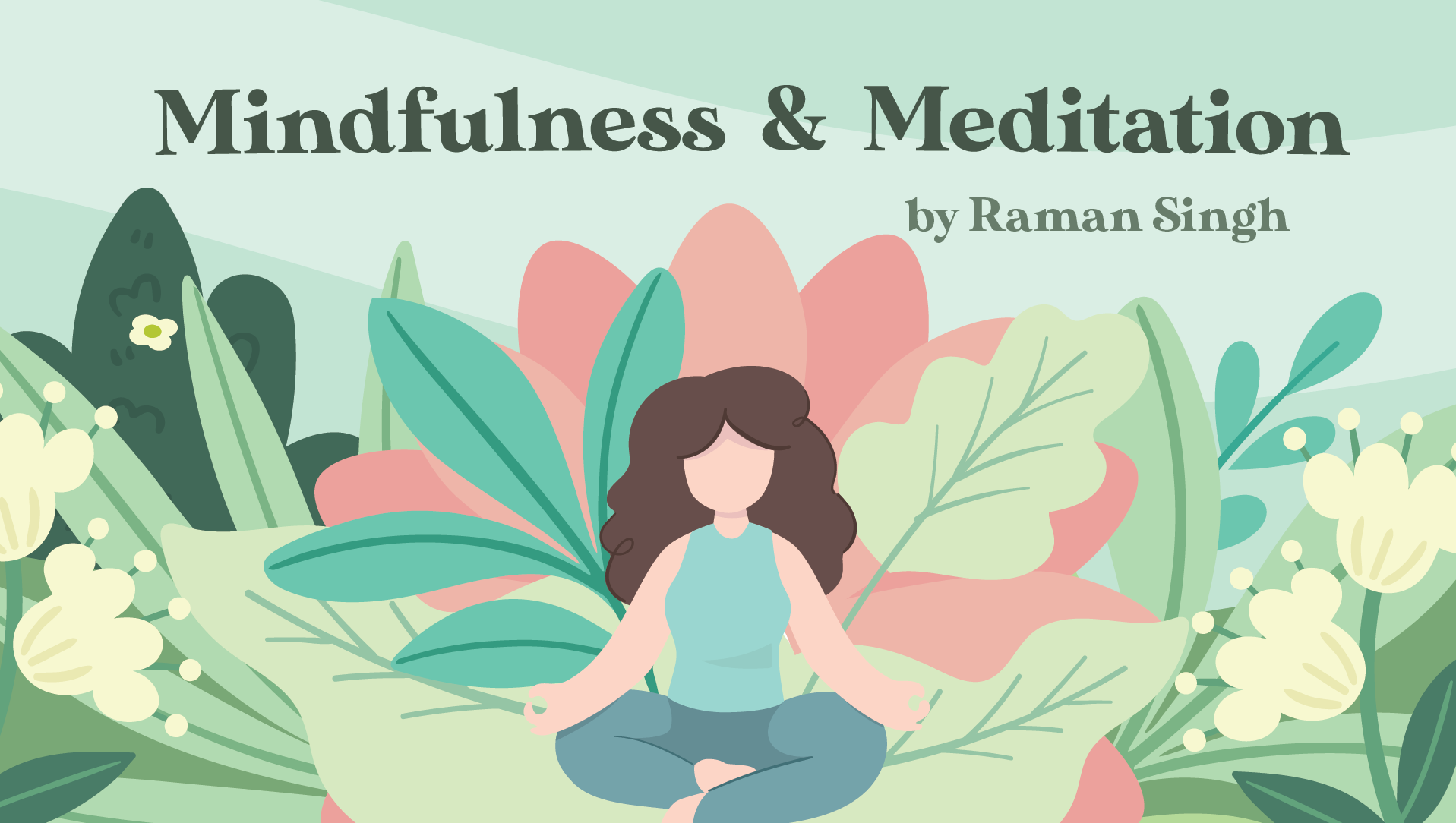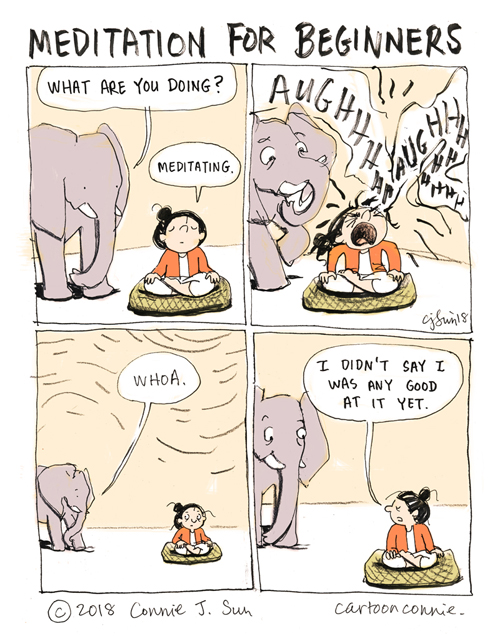Mindfulness and Meditation
Your mind is churning, your heart is pounding 24/7, and you're lying in bed awake every night. We're here to offer you a way out!

“Your mind is like this water, my friend. When it gets agitated, it becomes difficult to see. But if you allow it to settle, the answer becomes clear.” - Master Oogway

University is hard. I don’t think anyone would disagree with that. Deadline after deadline, assignment after assignment, it feels like the grind never ends. The amount of work we’re expected to complete in a week is already high, and then add on socialising, taking care of yourself, applying for jobs and internships - it’s no wonder that many students are under a ridiculous amount of stress. There's just too many things to do, and not enough time to do them. This mental and emotional strain can take a harsh toll on our mental health and can even lead to more serious conditions such as anxiety and depression.
Thankfully, one of the simplest things we can do to help manage our levels of stress and anxiety is… meditation! Meditation has become more and more popular over the years as a way to help relax and strengthen the mind and to achieve a clear mental state.
What even is meditation and why should I bother?
The English word ‘meditation’ is a very loosely defined term and can refer to many different things from various cultures such as dharana, dhyana, samadhi, vipassana, etc. For simplicity (and also to keep this as secular as I can), I’ll be defining meditation as a series of practices that help the mind develop its level of awareness and concentration. There are endless practices over the world of training the mind– they range from the Zen tradition where you sit yourself down and through extreme discipline, cast out all thoughts and remain with the pure experience of sitting (this is not so easy, try it yourself!) all the way to yoga asanas (postures) where you direct all of your attention to the body as you twist it into certain poses.
The beauty of meditation lies in its teaching that a deep, genuine sense of happiness and equanimity is available right here and now at no extra cost. It requires nothing outside of yourself, only courage and a willingness to leave what you know behind and experience the world as it really is. You will learn how the stress and negative thought patterns you experience are brought upon by your mind, examine the causes thoroughly and rip them out, root and stem. Meditation is also an act of kindness and compassion towards all other beings; you, of course, will benefit the most – but you are not the only one. When we are stressed and disturbed, we weaken ourselves and burden others – we might hurt them by the foolish things we do or say out of our weakness and fear. But, if your mind can learn how to stop causing itself stress, your hands are no longer full, and you can genuinely help others. The practice of meditation develops qualities such as honesty, integrity, and compassion – all of which I think we could do with a bit more in our lives.
Practices
Mindfulness

"We get so caught up in this endless thought-stream that reality flows by unnoticed. We spend our time engrossed in activity, caught up in an eternal pursuit of pleasure and gratification and eternal flight from pain and unpleasantness. We spend all of our energies trying to make ourselves feel better, trying to bury our fears, endlessly seeking security. Meanwhile, the world of real experience flows by untouched and untasted.” – Bhante Gunaratana
By far, the most famous and popular method of meditation in the Western world is mindfulness. This is because it’s very simple to do and you don’t even need to be meditating to practice it! Simply put, mindfulness is being aware of the present moment, and directing all your attention to what is happening now. Fully engaging in the here and now is not as easy as it appears; most of the time, we’re not really here - we’re somewhere else. Usually, we’re caught up in our thoughts about the past or the future or any number of irrelevant things we cannot really control. Mindfulness reminds us that the only reality is the immediate one, and joy can be present in every single moment we experience.
If you want to sit down and actually meditate however, you can do that as well! All you need to do is find a quiet place, ideally free from distractions, sit or stand however you want, take a couple of deep breaths, and just sit. See if you can focus your attention to wherever you feel the breath most strongly - some people find the sensation at the tips of their nostrils to be a good place to start; others might find the expansion of their belly to be satisfactory. All you have to do is relax, and see if you can direct your attention to the point you’ve chosen.
Of course, the mind is a machine and eventually it’s gonna do what it’s gonna do - think. Thoughts will pop in seemingly out of nowhere, and attempt to distract you from your breath. For the first couple of minutes, you won’t even realise your mind has drifted! All you need to do is notice when your mind has drifted, acknowledge that it has, and gently redirect your attention back to breath. Easy.

Every time your mind gets distracted, and every time you focus on the breath again, it’s like a bicep curl for your mind. The more you do this practice, the less often your mind will wander and the steadier your attention will become. When you’re completely focused on the breath, everything else seems to melt away, like your anxieties, your worries, anything that’s troubling you; because in that moment, you are only aware of your breath and nothing else. It is a deeply peaceful and wonderful experience, and I hope you can bring that state of mind to everything you do.
However, every mind is unique, and mindfulness will work for some, while it will fall flat for others. This is a common complaint people have after trying mindfulness - they say “Oh, I tried it and it just didn’t click.” or “I don’t think meditation is for me.” Luckily, there are so many different ways that you can meditate, and mindfulness is only a drop in the ocean in terms of meditative techniques. I will detail a couple below - I encourage you to try all of them at least once, and stick to the one you feel is most effective.
Body Scan
Body scan is a variant of mindfulness meditation that might be suitable for those who feel like they can’t focus on the breath and would like some other stimuli to direct their attention towards.
Sit or lie down and make yourself comfortable. Posture isn’t too important for this one - just make sure your spine remains straight. You can either close your eyes or maintain a ‘half-lidded’ gaze, where your eyes are half open and not focused on anything in particular. Take a couple of long, deep breaths and relax as much as you can. Then, slowly bring your attention to your body starting at the top of your head. Now, mentally scan down your body and be aware of all the sensations you can feel as you move down. Go through and move your attention to the neck, then the chest, your torso, your arms, and so on. See if you can notice any comfort or discomfort, any tension anywhere in the body. Don’t try to change anything. If you’re uncomfortable anywhere, just notice and focus your attention on it and just breathe. Spend a couple of breaths on each body part (roughly 20-30 seconds).
Kapalabhati - breath of fire
This is my personal favourite, and I’ve found it to be extraordinarily helpful whenever my mind starts racing - like just before a big exam or while I’m trying to study. Usually after performing this one, I gain a great deal of energy and my mind feels still. This is a meditation technique where exhalation is forceful, and inhalation is passive - the opposite of normal breathing.
- Sit down and get comfortable in a place where you won’t be distracted.
- Breathe in and out a couple of times, just to get ready and centre yourself.
- Take in a deep breath and try to inhale as much as possible, filling the lungs.
- Forcefully exhale 10 times. Focus on the contraction of the diaphragm as you breathe out. Focus all your attention on the exhalation until you’ve run out of breath. It might be helpful to focus on the belly expanding and contracting rapidly.
- Once you’ve run out of breath, see if you can empty the lungs even further.
- Then take a deep breath in and try again, this time increasing the number of exhalations as much as you want. Personally, I start with 10 and make my way up to 40, increasing the number of exhales after each deep inhalation.
- Once you’ve done as many rounds as you want, return to your normal pattern of breathing and just sit. Don’t pay attention to anything in particular; just sit and observe.
Parting Words
Try some of these techniques out the next time you’re stressed! The journey of meditation is difficult and daunting at first, but the fruits of your labour will be oh so sweet – don’t take my word for it though; see for yourself!
